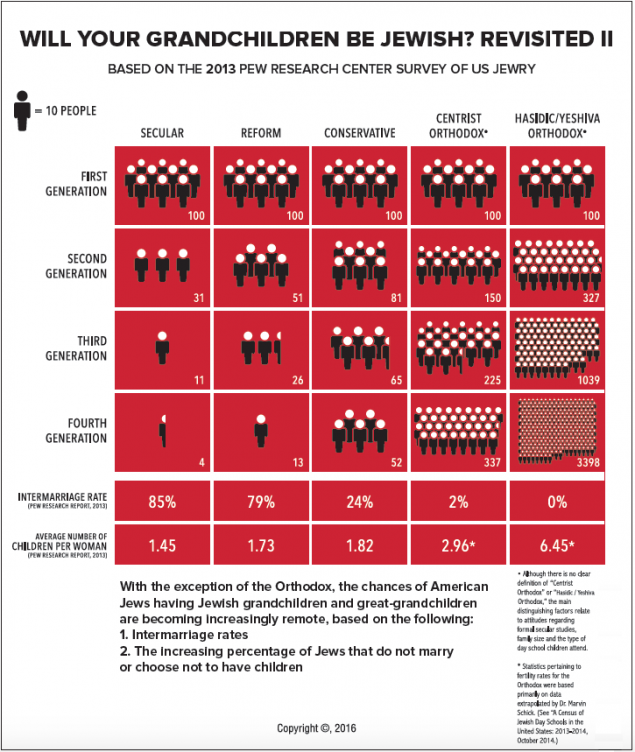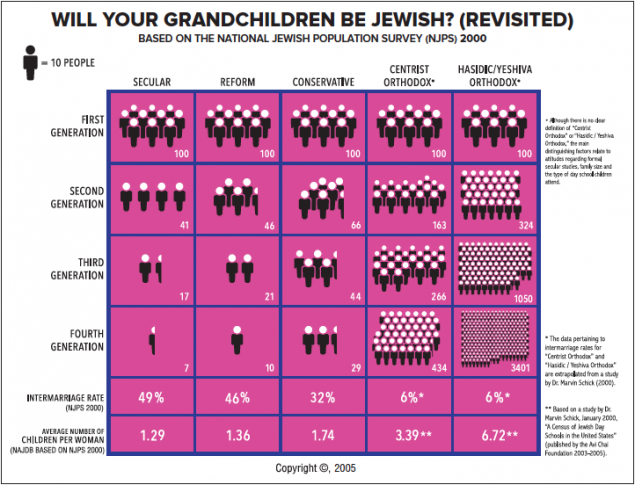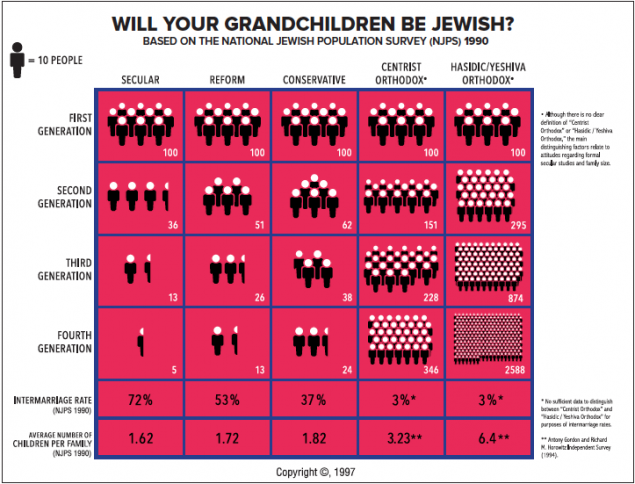American Jewry: Where Are We Now? Where Are We Heading? Two Views
In the aftermath of the devastating revelations of the 1990 National Jewish Population Study, Antony Gordon and Richard Horowitz, Los Angeles-based businessmen and Jewish communal activists, co-authored “Will Your Grandchild Be Jewish?,” a chart that vividly depicted the disintegration of the American Jewish community. The chart was translated into several languages and appeared in numerous publications including the New York Times and The Vanishing American Jew by Professor Alan M. Dershowitz. Gordon and Horowitz had based their projections on the 1990 study; subsequently, when the National Jewish Population Study of 2000 was released, they updated their chart, using fresh data.
Below is the latest version of their now-famous demographic chart. This version, which took months of research, is appearing for the first time in print in these pages. The chart is based on the raw data of the most recent national demographic study of American Jewry—the Pew Research Center’s 2013 survey of American Jews. Working for months with Alan Cooperman, director of religion research at Pew Research Center, and other sociologists and demographers, Gordon and Horowitz recently completed this version.
In the articles below, Dr. Marvin Schick, the well-known Jewish educational expert and devoted communal leader, and the authors of the charts analyze the extrapolations and conclusions of all three charts, created over three decades. Essentially, they seek to answer one overriding question, burning in the hearts of all thinking Jews: Where is American Jewry headed? Somewhat surprisingly, Dr. Schick and Gordon/Horowitz arrive at different conclusions. We invite you, our readers, to submit your own thoughts and perspectives about this vitally important question concerning the future of American Jewry.
The chart above illustrates the effects of intermarriage and birthrates in the American Jewish community. According to the chart, based on the raw data of the Pew Research Center’s 2013 survey of US Jewry, after four generations, secular Jews will produce 4 Jewish great-grandchildren while “Hasidic/Yeshiva Orthodox Jews” will produce nearly 3,400 Jewish great-grandchildren.
A cursory comparison of the three charts (produced in 1990, 2000 and 2016) would seem to indicate that there have not been any major demographic changes from one survey to another. According to Gordon and Horowitz, this is due to the fact that over time, the definition of Jewish identity has become more widely construed.
The sad reality is that save for the Orthodox denomination, fertility rates remain below zero population growth and intermarriage rates continue to rise. Moreover, the 2013 Pew Research Center’s survey of American Jews highlights additional disturbing trends, including the fact that many couples who choose to marry do so at an older age, and even then, often choose not to have children.
By Marvin Schick
The achievement of Antony Gordon and Richard Horowitz is extraordinary. In a community blessed—and some may say inundated—by millions of printed words describing and discussing in every possible way the state of American Jewry, in a single chart they have focused our attention on the stark statistics of American Jewish loss and they have compelled us to contemplate what the Jewish future in the US will look like. Their work is a seminal development in recent Jewish history.
Their chart—or perhaps more accurately their charts, as there now have been three—is the handiwork of two dedicated persons. Because none of us is blessed and imbued with the capacity to attain perfection, what we produce and write is open to analysis and even challenge. It is no service to Messrs. Gordon and Horowitz and certainly not to our community to refrain from subjecting their statistics to the scrutiny that commonly is directed at important demographic research. Precisely because their statistics and analysis deal with a matter of transcendent concern to our people, we are obligated to carefully examine what they have presented and, when thought necessary, to raise questions.
There is also the consideration that because we cannot predict the future with anything approaching exactitude, their work is subject to questioning and even challenge. It is also relevant that their statistics have had three incarnations and that the second revised what was presented in the first, and the third revised what was presented in the second. There cannot be a clearer indication that their work is not imbued with certainty.
What is certain is that as has occurred throughout the entire American Jewish experience, there will be substantial losses from our ranks. What I question is the timetable that Gordon and Horowitz put forth, as well as the numbers that are the bread and butter of their timetable.
Demography or population studies are the starting point for any analysis of the future of American Jewry. We have had quite a few Jewish population studies, my hunch being more than any other American religious or ethnic group. All contemporary demographic discussion of American Jewry focuses on the 1990 National Jewish Population Survey (NJPS) which showed that in the period immediately preceding that research, the intermarriage rate among American Jews, excluding the Orthodox, had reached the 50 percent level. This set off alarms that continue to ring.
Although it may be obvious, it needs to be mentioned that demographic research is predicated on identity and, more accurately, on self-identity. Judaism is a religion, but our demographic research is not predicated on an halachic determination of who is Jewish, but rather on what may be referred to as a sociological definition under which essentially persons who say they are Jewish are regarded as Jewish. Intermarriage is a subject that is crucial to Jewish demographic research but it does not determine who is included. Accordingly, intermarried Jews and their offspring, as well as spouses and others who live in a Jewish household and identify themselves as Jewish are regarded as Jewish by our demographers.
Interestingly, our demographers exclude persons born to two Jewish parents who have embraced another religion or aver that they are of no religion. This results in the curiosity that if we reckoned our numbers using the halachic standard, there would be more American Jews than are currently indicated by our demographers.
For decades, our population research has hovered at the six million figure, this despite there being at least two million Americans who were Jewish by birth but who are not included because they say they are not Jewish. The stability in our numbers is also fascinating in view of a fertility rate for the non-Orthodox that is significantly below zero population growth. Another factor that should reduce our numbers is aliyah. Nefesh b’Nefesh recently announced that since 2002, 50,000 persons have made aliyah through its auspices. These olim are primarily from the United States and are mostly younger persons. Of course, many American Jews who have not used Nefesh b’Nefesh have settled in Eretz Yisrael.
On the other side of the ledger, there are Russian Jews as well as yordim or ex-Israelis who arrived here after 1990. They obviously have added to our statistics, although Jews from the Former Soviet Union have abandoned in droves any sense of Jewish identity. The large network of activities aimed at strengthening their Judaic ties is nearly all gone with the wind. I take no satisfaction in noting this.
However we look at these demographic pieces, at the end of the day we are left with the familiar six million Jews statistic. Put otherwise, as we enter the third generation previously outlined in the Gordon-Horowitz chart, each of its versions projected far greater losses than have occurred.
The lesson is that we can project and predict, but even if we are as careful and faithful to the data as Gordon and Horowitz are, we are in the territory of “mensch tracht, und Got lacht” [literally, man plans and God laughs], which means in the context of demography that as meticulous as we may be with our methodology and as faithful as we may be to the data, there are severe limits to our ability to divine what lies a generation and more down the road.
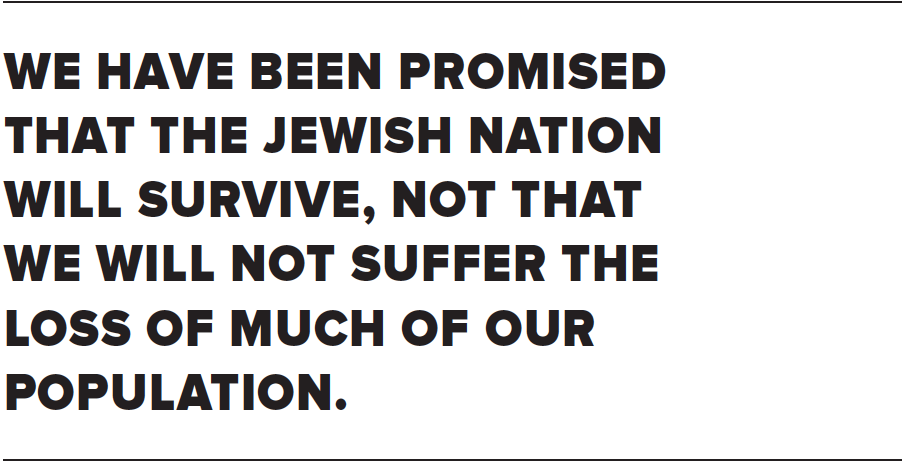 The question therefore is why this staying power of American Jewry, at least in demographic terms? Why in the face of an intermarriage rate of 70 percent (as per the 2013 study by the Pew Research Center) are we resilient, not in a religious or traditional sense, but certainly in terms of identity? Why have we not assimilated far more rapidly?
The question therefore is why this staying power of American Jewry, at least in demographic terms? Why in the face of an intermarriage rate of 70 percent (as per the 2013 study by the Pew Research Center) are we resilient, not in a religious or traditional sense, but certainly in terms of identity? Why have we not assimilated far more rapidly?
Part of the answer, again, is the nature of our demographic research. It readily accommodates what can be termed “Jewish lite.” Membership in our community comes on liberal terms and so there is less of an incentive to leave. We should make no mistake about this: for a generation or even longer we have watered down what it means to be a Jew and this watering down helps us keep our numbers up.
It is telling that no one in the Orthodox community is objecting to the statistic of six million Jews, nor is the suggestion being made that an asterisk should be placed next to the number, pointing out that the data conform to a non-halachic version of Jewish identity and that if halachic criteria were employed, our numbers would be substantially lower.
But Messrs. Gordon and Horowitz say that this cannot last. They are right. It cannot. If present conditions are maintained, the prospect is that our numbers will be somewhat lower twenty years down the road, but certainly not anything as close to as low as they have projected.
Let’s focus on a single statistic: the rise of the intermarriage rate in the recent period among the non-Orthodox to 70 percent. This represents a remarkable increase of nearly 1 percent per year since the frightening 50 percent intermarriage rate indicated by NJPS 1990. Yet nearly a generation after that research and all that it disclosed, our demography continues to indicate that there are about six million American Jews.
This is an epic development, even as we may strongly disapprove of intermarriage and aver that there will be a day of reckoning when those who have married out and their future generations will be nearly entirely gone from our ranks. For all of our sincere concern about the Jewish future, we live in the present and what we do is in the present. Right now, the likelihood is that the profile of the Jewish community saturated with non-halachic Jews will have greater staying power than had been thought possible. This is an astounding development, something not seen with such force or consequence for more than two thousand years or since the inter-Temple period when a large proportion of Jews living in exile in Babylonia were intermarried and, nonetheless, there were many who affirmed their Jewish commitment and identity. These included community leaders and many who yearned to return to the Land of Israel.
In a word, we are losing millions who have rejected Jewish identity and we are retaining several million who have retained their Jewish identity even if they have walked away from much of what this identity has encompassed. This development seems more remarkable when we reckon the vast size of the United States and the dispersal of Jews throughout the continent, factors that should contribute to the total abandonment of Jewish identity.
What accounts for the determination to cling to Jewish identity in the face of an assimilatory avalanche that has throughout nearly all of our history triggered immense Jewish loss and abandonment? The answer is certainly not mystical, meaning that one of the blessings inherent in our peoplehood is the guarantee that we will not vanish entirely from the face of this earth. This blessing—covenant may be a more appropriate term—is assuredly critical to our survival, yet it obviously has not been a surety against massive demographic loss due to Judaic abandonment. Too much of our history tells us otherwise. We have been promised that the Jewish nation will survive, not that we will not suffer the loss of much of our population.
What then is the explanation for the endurance, at least in a sociological sense, of several million American Jews who care little about the religion that has been the foundation for Jewish survival over the centuries? Why haven’t most of us vanished into the great American melting pot? We have been treated ever since the 1990 NJPS to confident predictions of the vanishing American Jew, and although the predictions are still with us, so are about six million Americans who continue to identify as Jewish.
One certain factor is the highly positive image of Jews in the American mindset. We must never underestimate how strong antagonism toward Jews contributed mightily to the abandonment of Jewish identity for several generations in pre-Holocaust Europe. The perception among many was that the cost of remaining Jewish was too high.
The favorable attitude toward Jews in this country has contributed greatly to the retention of Jewish identity in the face of fierce assimilatory forces. While there may not be specific rewards in being identified as Jewish, certainly among the general American population this identity is regarded as meritorious. These lines were written shortly after the two presidential nominating conventions. It is telling that each of the major candidates is a Christian who has an avowedly Jewish son-in-law.
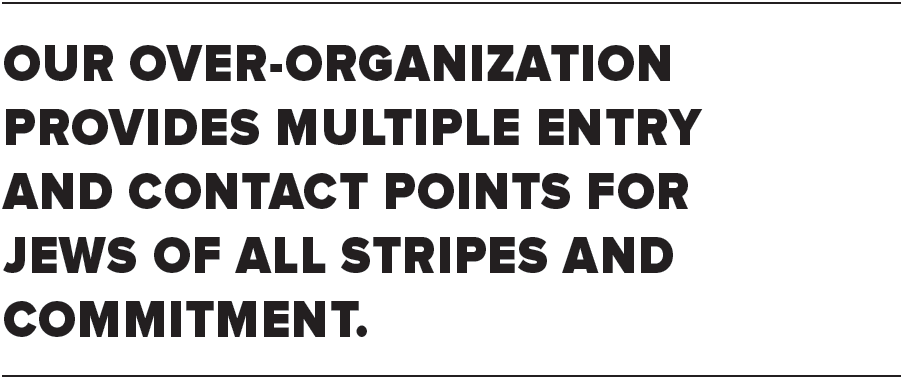 This remarkable circumstance is testimony to the American ethos of tolerance, of accepting persons as they choose to be identified, provided that they do no harm. I believe that this also tells us that despite their rigorous standard of Jewish identity, so that only a person born of a Jewish mother or has converted according to halachah is Jewish, the Orthodox have managed to be dualistic in their reaction to intermarriage. They continue to employ the halachic definition, even as there is tacit acceptance of sociological reality. Put otherwise, I do not know of a single instance where an Orthodox Jewish writer has declared that the figure of six million American Jews is false and that, in truth, the number is no more than half that figure.
This remarkable circumstance is testimony to the American ethos of tolerance, of accepting persons as they choose to be identified, provided that they do no harm. I believe that this also tells us that despite their rigorous standard of Jewish identity, so that only a person born of a Jewish mother or has converted according to halachah is Jewish, the Orthodox have managed to be dualistic in their reaction to intermarriage. They continue to employ the halachic definition, even as there is tacit acceptance of sociological reality. Put otherwise, I do not know of a single instance where an Orthodox Jewish writer has declared that the figure of six million American Jews is false and that, in truth, the number is no more than half that figure.
We can contrast this experience with what transpired in pre-Nazi Germany. The community led by Rabbi Samson R. Hirsch, an epic religious figure in nineteenth-century Germany, insisted on separation from much of the rest of German Jewry, including other Orthodox Jews, on theological grounds that certainly would not be accepted as reasons for separation within American Orthodoxy. The contrast between what had occurred in Germany and what we are experiencing here is accounted for by the part that tolerance plays in the American mindset, something that was far from the case in Germany.
Israel serves as a strengthening agent for a large number of American Jews for whom religious commitment has withered away. It’s true that only a relatively small proportion of non-Orthodox Jewish Americans have visited Israel. Yet, its existence and achievements reinforce whatever elements of Jewish peoplehood remain alive in the minds and hearts of many of these Jews. It is relevant that the American Jewish population includes a large number of ex-Israelis or yordim, as well as their spouses and offspring. Although unfortunately they have not been immune from the strong assimilatory forces that have swept through American Jewish life, the fact that many have family in Israel obviously reinforces their ties to the Jewish State and, in turn, this reinforces their identity as Jews.
Perhaps the most fascinating and, indeed, compelling factor restraining the abandonment of Jewish identity is the staggering size and character of our organizational and institutional life. Our multi-billion dollar communal edifice of activities and organizations that for good reason has often been derided as duplicatory and ineffective has in some dialectical sense served as a magnet to draw Jews closer to feelings of Jewish identity.
As the role of once seemingly imperious national Jewish organizations fades, what remains are robust manifestations of local community life, including community centers, Federations, synagogues, camps, chapters of major organizations and a great deal more. In the aggregate, our over-organization provides multiple entry and contact points for Jews of all stripes and commitment, specifically including those whose identity falls into the sociological category.
Logic and experience suggest that this cannot last. After all, each successive generation has been weaker in its attachment to meaningful Jewish life. The low American Jewish fertility rate and the continued losses that will occur among those who have abandoned nearly all of what constitutes Jewish identity make it certain that the ranks of ex-Jews will swell and the number of sociological Jews will decline.
But logic and experience do not necessarily govern history going forward. We are a generation after the 1990 NJPS. Our numbers have held up, even as religious commitment and the number of halachic Jews have declined. As long as the overall Jewish community embraces the notion of sociological Jews and the factors that contribute to Jewish losses are themselves somewhat retarded, we shall remain distant from the moment when the number of American Jews plummets to the point that has been predicted.
I imagine—and certainly hope—that Messrs. Gordon and Horowitz will continue to carefully monitor what is occurring in American Jewish life. If they do, it is more than a good bet that they will see that life has a way of playing tricks and that although for a very long while American Jewry has been in trouble, somehow their projections did not quite hold up.
Dr. Marvin Schick, a senior advisor to the Avi Chai Foundation, has been active in Jewish communal life for two-thirds of a century and for nearly half a century, he has served as president of the Rabbi Jacob Joseph School, a voluntary undertaking.
By Antony Gordon and Richard M. Horowitz
We are honored and humbled by the complimentary words stated by Dr. Marvin Schick in his thoughtful piece in response to the publication of our 2016 chart “Will Your Grandchild Be Jewish?”
We owe Dr. Schick a debt of gratitude, not only for his magnanimous comments, but also for taking the time on several occasions to participate in conference calls with us during the course of the most recent iteration of the study as well as the prior iterations. The decades of research and commitment that Dr. Schick has invested in klal-related material is outstanding, and no intellectually honest researcher or lay leader involved in American Jewry today can ignore the unique insight and wealth of knowledge that Dr. Schick has to offer.
Before commenting on Dr. Schick’s remarks, we want to make a few points:
Firstly, as Dr. Schick mentioned, at all times we were “. . . careful and faithful to the data” in our research. More specifically, the most recent version of the study was the culmination of many months of exhaustive research based on an analysis of the raw data of the 2013 Pew Report entitled “A Portrait of Jewish Americans.” Secondly, the clear premise of the three versions of the chart which was clearly corroborated by Dr. Schick, is the fact that “. . . we are losing millions who have rejected Jewish identity . . .”
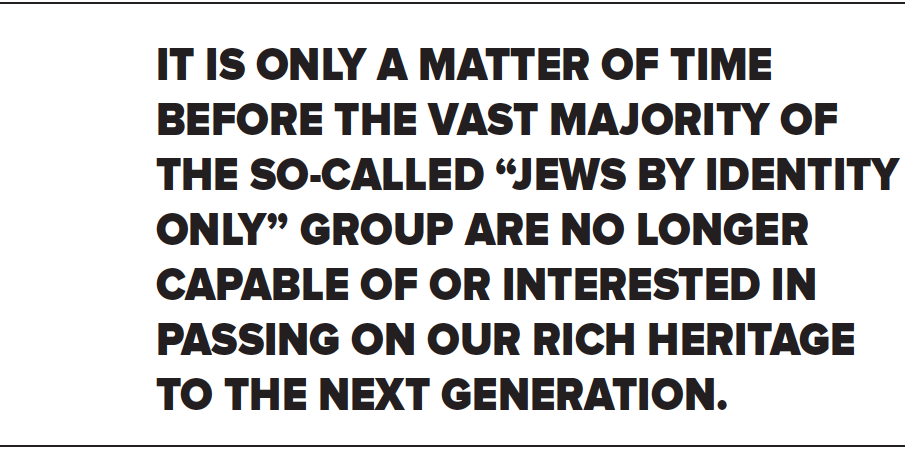 Any differences in the approach between us and Dr. Schick are at best illusory and perhaps come down to mere semantics. The overriding theme of Dr. Schick’s article is that there exists in America today a significant portion of Jews who while they identify as Jews, have negligible involvement in Jewish life and do not adhere to mitzvot or a Torah lifestyle. When it comes to any major Jewish population survey, this portion of American Jews results in the creation of a kind of “sociological optical illusion” which masks the fact that over the next three generations, the majority of American Jews are on track to disappear into spiritual oblivion.
Any differences in the approach between us and Dr. Schick are at best illusory and perhaps come down to mere semantics. The overriding theme of Dr. Schick’s article is that there exists in America today a significant portion of Jews who while they identify as Jews, have negligible involvement in Jewish life and do not adhere to mitzvot or a Torah lifestyle. When it comes to any major Jewish population survey, this portion of American Jews results in the creation of a kind of “sociological optical illusion” which masks the fact that over the next three generations, the majority of American Jews are on track to disappear into spiritual oblivion.
Simply stated, the only point which Dr. Schick takes issue with in our most recent version of the study is his belief that the so-called twenty-year timeline is too pessimistic. In real terms, there is very little disparity between our conclusion and the comments noted by Dr. Schick, as explained below.
Current “Demographic Topology” Versus Predicting The Future
We wholeheartedly agree with Dr. Schick’s comment that “there are severe limits to our ability to divine what lies a generation down the road.” That said, we have been at pains to point out that our chart is not intended to be a prognostication but rather the functional equivalent of a “screen shot” of sorts, intended to illustrate the consequences of people’s spiritual decisions or denominational affiliation.
One need not look further than the fact that the only denomination whose average family size exceeds zero population growth and whose intermarriage rates are negligible is the Orthodox denomination.
It follows, and is borne out by the data, that when Jews make the kind of decisions that cause them to move further away from a traditional Jewish lifestyle of adhering to mitzvot, the chances of having an identifiable Jewish grandchild with the ability to “carry the torch” of traditional Jewish teachings and values diminishes exponentially.
“A Mile Wide But a Half-an-Inch Thick”
While we have only respect for Dr. Schick, his remarks about the “staying power of American Jewry, at least in demographic terms” because American Jews still have the proclivity to “identify” as Jews albeit “not in a religious or traditional sense” flies in the face of thousands of years of Jewish history. One need look no further than the arrival of millions of Jews in America between 1882 and 1922 to see the fallacy of this line of thinking.
Rabbi Berel Wein has been known to remark that for many of the Jews who arrived in America during this period, Judaism may have appeared to be a “mile wide” but it was only “a half-an-inch thick.” By the latter quip, Rabbi Wein meant that while a large portion of Jews who arrived in the United States during the turn of the century and after World War I may have identified as Jews, they did not have a deep religious connection to Judaism. Understandably, therefore, there was no compelling reason for them to remain within the fold when they arrived in the “melting pot” of America at a time when observing Shabbat meant more often than not being unable to hold down a job.
In other words, even if the point Dr. Schick articulates so well—i.e., that against many odds, a large percentage of American Jews still identify as Jews in response to a question in a population survey—history has shown that this portion of Jews are standing on demographic quicksand and sadly, it is only a matter of time before the vast majority of the so-called “Jews by Identity Only” group are no longer capable of or interested in passing on our rich heritage to the next generation.
Antony Gordon is a Sir Abe Bailey fellow, Fulbright scholar and graduate of Harvard Law School. He was a senior vice president at Morgan Stanley before launching Stealth Capital Management, LLC, a merchant bank and wealth management consulting firm. Mr. Gordon is a sought-after speaker and has been active in Jewish outreach for more than twenty-five years.
Richard M. Horowitz received his MBA from Pepperdine University in California. He is the president of Management Brokers Insurance Agency and chairman of Dial 800 L.P. A well-known philanthropist, he is very active with a number of Jewish nonprofit organizations.

